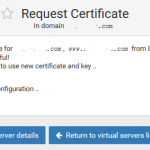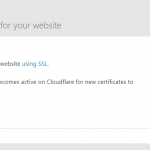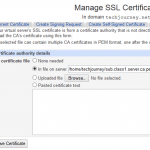For example, Apache plugin for Let’s Encrypt currently only supports Apache 2.4 running on a Debian-based OS with version 1.0+ of the libaugeas0 package.
Follow the following guide to create and generate the free Let’s Encrypt SSL Certificate, and then install and setup the SSL certificate for your websites. The guide will make use of common “authenticator” plugins which should available on all systems by default, which make available different ways of verification of ownership.
letsencrypt plugins
For Let’s Encrypt client obtained manually the comes with letsencrypt-auto, the client (letsencrypt binary) is available inside the virtual environment it created: /home/user/.local/share/letsencrypt/bin/letsencrypt.
Web Root Verification
If you have a running webserver for which you have the ability to modify the content being served, and you prefer not to stop the webserver during the certificate issuance process, the webroot plugin can automatically create the response to the ACME challenge.
The syntax for the web root verification is:
letsencrypt certonly --webroot --webroot-path /var/www/html/ \ --domains techjourney.net --domains www.techjourney.net \ --webroot-path /var/www/seconddomain --domains www.seconddomain.com \ --renew-by-default --agree-tos --email [email protected]
Apache Verification
If you are running Apache 2.4 on a Debian-based OS with version 1.0+ of the libaugeas0 package available, use the following command with Apache plugin to automate both obtaining and installing certs on an Apache webserver.
letsencrypt --apache --domains techjourney.net --domains www.techjourney.net \ --renew-by-default --agree-tos --email [email protected]
Standalone Verification
Standalone verification uses a standalone webserver to automatically responds to the challenge to obtain a cert. The downside of this method is that the existing web server must be temporarily stopped as Let’s Encrypt standalone webserver must bind to port 80 or 443 in order to perform domain validation. The advantage is that
letsencrypt certonly --standalone --standalone-supported-challenges http-01 \ --domains techjourney.net --domains www.techjourney.net \ --renew-by-default --agree-tos --email [email protected]
--standalone-supported-challenges tls-sni-01 to use port 443
Manual Verification
Manual verification allows you to run the LetsEncrypt client on a separate system from the web server which hosts the domains which certificates are required.
letsencrypt certonly --manual \ --domains techjourney.net --domains www.techjourney.net \ --renew-by-default --agree-tos --email [email protected]
As it’s manual generation of SSL certificate, the Let’s Encrypt client will prompt for a secret per domain to be stored at specific locations. Run the following commands to set the secret location.
cd /var/www/html mkdir -p .well-known/acme-challenge echo "random strings" > .well-known/acme-challenge/random-file-name
Once Let’s Encrypt ACME server manages to test and match the site with the secret provided, Let’s Encrypt will provide the certificate.
# Use a 4096 bit RSA key instead of 2048 rsa-key-size = 4096 # Register with the specified e-mail address email = [email protected] # Uncomment and update to generate certificates for the specified domains. # domains = example.com, www.example.com # Use a text interface instead of ncurses text = True # Use the standalone authenticator on port 443 authenticator = standalone standalone-supported-challenges = tls-sni-01 # Uncomment to use the webroot authenticator. Replace webroot-path with the # path to the public_html / webroot folder being served by your web server. # authenticator = webroot # webroot-path = /usr/share/nginx/html # If a certificate already exists for the requested domains, renew it now, # regardless of whether it is near expiry. renew-by-default = True # Agree to the Let's Encrypt Subscriber Agreement agree-tos = True
Place the cli.ini in /etc/letsencrypt/cli.ini, $XDG_CONFIG_HOME/letsencrypt/cli.ini or ~/.config/letsencrypt/cli.ini (if $XDG_CONFIG_HOME is not set). You can also specify the path to the configuration file with –config or -c switch. For example:
letsencrypt --config /etc/letsencrypt/cli.ini -d yourdomain.com -d www. yourdomain.com certonly
Set Up Apache HTTPD Web Server with Let’s Encrypt SSL Certificate
Let’s Encrypt creates the SSL certificates in /etc/letsencrypt/live/domain_name directory. For example, for Tech Journey, it’s created in /etc/letsencrypt/live/techjourney.net folder. Essentially, 4 files are generated:
privkey.pem: Private key for the certificate (SSLCertificateKeyFile for Apache and ssl_certificate_key for Nginx)
cert.pem: Server certificate only (SSLCertificateFile for Apache < 2.4.8)
chain.pem: All certificates that need to be served by the browser excluding server certificate, i.e. root and intermediate certificates only (SSLCertificateChainFile for Apache = 1.3.7)
fullchain.pem: All certificates, including server certificate, i.e. concatenation of chain.pem and cert.pem (SSLCertificateFile for Apache >= 2.4.8 and ssl_certificate for Nginx)
It’s recommended to keep all SSL certificates inside its original directory for easy maintenance and renewal, instead of moving it to another location. Thus, whenever possible, point the web server configuration to directly make use of the files and create symlinks to the right location.
An example configuration for mod_SSL of Apache HTTPD web server running virtual hosts, where symbolic links are required:
ln -s /etc/letsencrypt/live/techjourney.net/cert.pem /etc/pki/tls/certst/techjourney.net.crt ln -s /etc/letsencrypt/live/techjourney.net/privkey.pem /etc/pki/tls/private/techjourney.net.key ln -s /etc/letsencrypt/live/techjourney.net/chain.pem /etc/pki/tls/certs/techjourney.net.chain.crt
Then, update the ssl.conf (or httpd.conf or apache2.conf):
LoadModule ssl_module modules/mod_ssl.so Listen 443 <VirtualHost *:443> ServerName techjourney.net ServerAlias www.techjourney.net DocumentRoot /var/www/_html ErrorLog /var/log/techjourney.net_error_log CustomLog /var/log/techjourney.net_access_log combined <Directory /var/www/html> allow from all AllowOverride All Options=ExecCGI,Includes,IncludesNOEXEC,Indexes,MultiViews,SymLinksIfOwnerMatch </Directory> SSLEngine on SSLCertificateFile /etc/pki/tls/certst/techjourney.net.crt SSLCertificateKeyFile /etc/pki/tls/private/techjourney.net.key SSLCertificateChainFile /etc/pki/tls/certs/techjourney.net.chain.crt </VirtualHost>
Restart the Apache HTTPD web server after configuring:
service apache2 reload
service httpd restart
systemctl restart httpd
letsencrypt --help all







